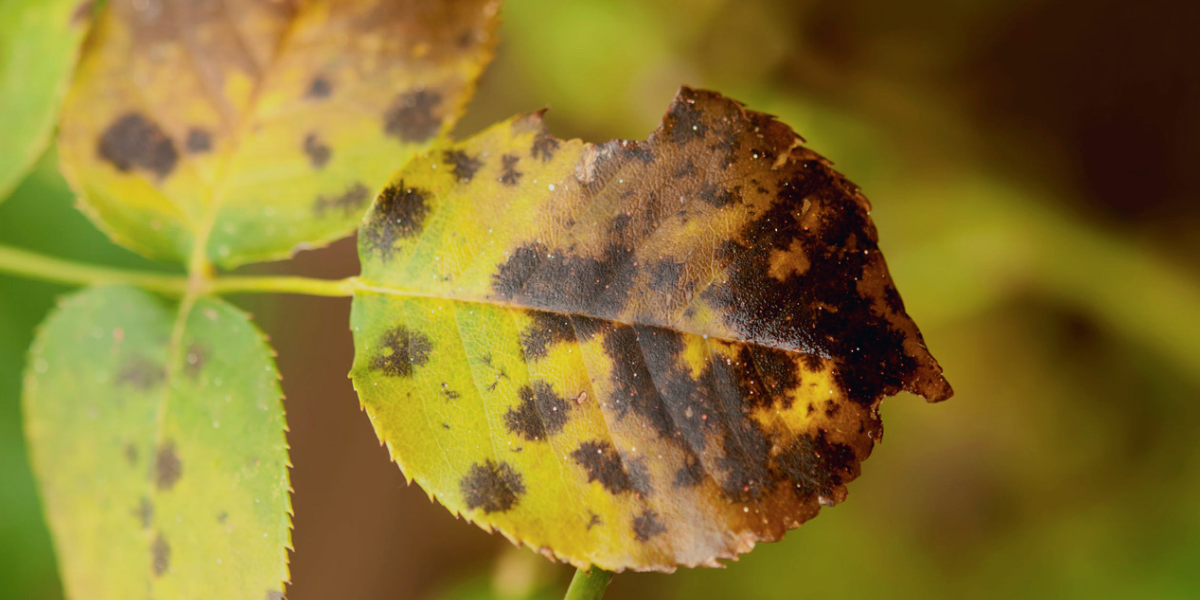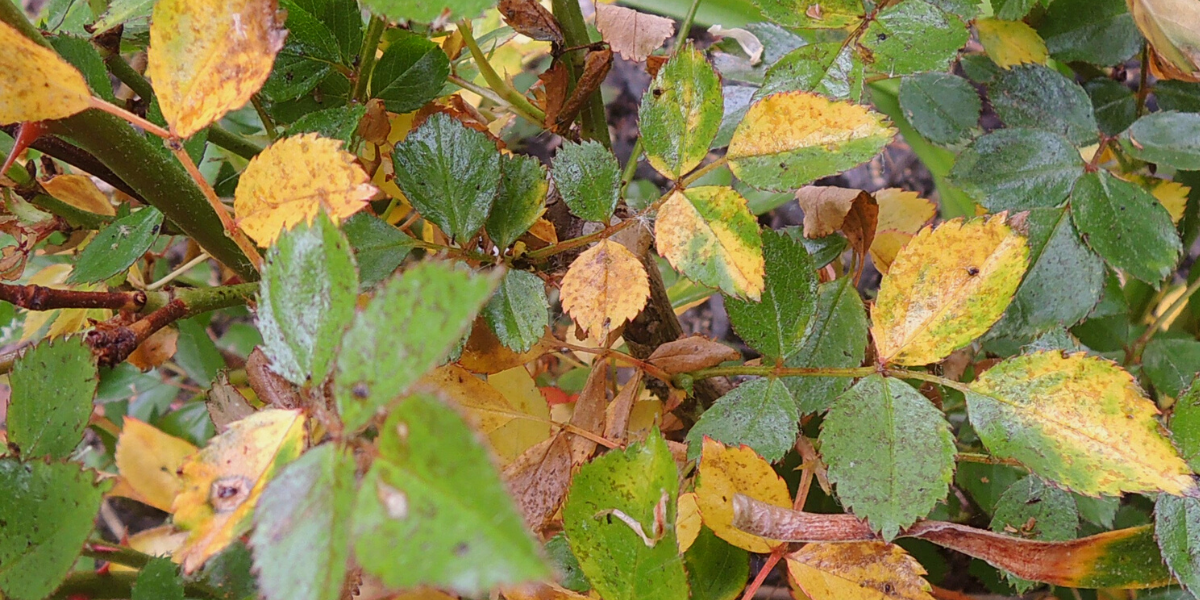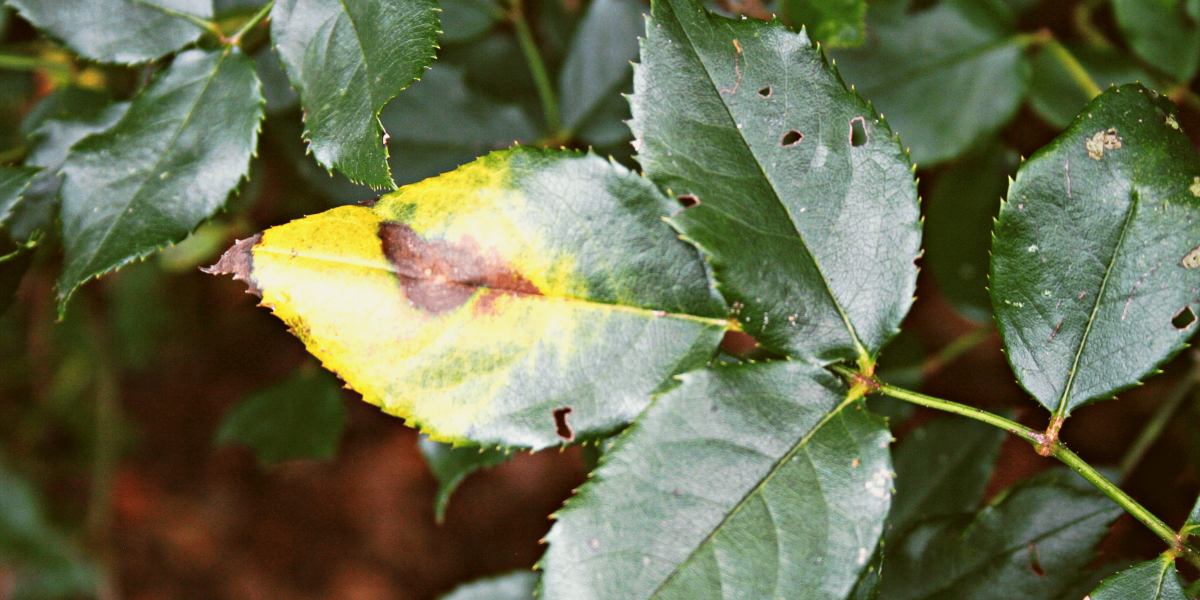Rose bushes are quite common in gardens and parks, but these plants can also be grown in pots at home. In nature, there are more than 30000 species. All of them are beautiful in their own way and can become a real gem of your house and yard. Often, gardeners are faced with the fact that rose leaves turning yellow. It greatly ruins the overall beauty of bushes and can also serve as an important indicator of dangerous diseases. Let’s discuss the causes of leaf color changes and how to stop this problem from spreading to the entire bush and neighboring plants.
Yellow Leaf on Roses Overview
Yellow leaf disease, when the leaves of plants turn yellow, has the scientific name chlorosis. This condition appears due to the inhibition of photosynthesis and the chlorophyll formation responsible for the green tint. There can be many reasons for this state. They can be divided into two large groups: infectious and non-infectious. Each group contains several items. Let’s take a closer look at each reason for the appearance of yellow leaf on roses.
Non-infectious chlorosis:
- Wrong care conditions. Although roses can be grown in pots, they are still intended to grow outdoors, in the so-called open ground. If the optimal routine is violated, these bushes may turn yellow. With an increase or decrease in ambient temperature, a strong reduction in the air humidity level, and a lack of lighting, the processes responsible for photosynthesis are greatly slowed down, and yellow leaf on roses appear.
- Overwatering. This reason should be taken out in a separate paragraph since it often leads to problems with indoor plant health. Overwatering or poor drainage causes the rose roots to be constantly in the water and soak. Because of it, they rot, which disrupts the metabolism. The leaves turn yellow, and they darken and die after a while.
- Nutritional deficiencies. Rose bushes need to be fed, especially if they grow not outdoors but in a pot. The soil is depleted over time, and the plant needs additional feeding. Flowers require iron, nitrogen, magnesium, proteins, manganese, potassium, etc., to grow properly.
- Inappropriate soil acidity. Roses do best in neutral to slightly acidic soil (5.6-7.0 pH). Deviations in any direction lead to disruption of internal processes and the appearance of yellow leaf on roses.
Infectious chlorosis:
- Pests. The appearance of pests is partly due to improper care routines, as weakened roses do not resist insects well. Pests, in turn, can bring a variety of bacteria and viruses that provoke plant diseases that are difficult to treat. Most often, you can find aphids, thrips, and spider mites on roses.
- Infections and fungi. Pests bring them, or they can be brought along with infected soil, unsterilized garden tools, or a diseased new plant. There are thousands of diseases that affect rose bushes and cause yellow leaf on roses, but powdery mildew, peronosporosis, and rose rust are among the main ones.
- Viruses. Bringing viral infections into your garden is highly undesirable, as it is complicated to stop the disease cycle. The mosaic virus and aster yellows can easily spread from the rose bush to your other flowers. It is best to keep these diseases out of your yard and take preventive measures.
There is also hereditary chlorosis; a mutation passed on to all young plants you get from old ones. This variation is not a critical condition that you need to treat. On the contrary, the feature is often used in rose breeding to give the bushes a unique look. At the same time, albinism, which can be observed in roses in the early stages of development, is fatal. It is impossible to cure such a plant.

We can say that the root cause of the leaves on rose bush turning yellow is the wrong conditions of maintenance and care. They can themselves provoke a change in the color of the foliage, as well as make plants vulnerable to pests, bacteria, and viruses. To ensure that the rose bush is fine is not easy. Therefore, before buying a flower, make sure that you can provide it with the right conditions, close to ideal.
Yellow Leaf on Roses Symptoms and Diagnosis
To ensure that the yellowing of the leaves is not due to dangerous roses diseases but to improper watering or lack of lighting, you need to inspect the bushes for other symptoms that could indicate a problem. It might not be easy to do it on your own, especially for beginner growers. It is best to use a specialized application to detect and accurately determine the problem on time:
- To identify the type of chlorosis (the cause of yellow leaf on roses), you need to get photos of the entire rose bush, including the root system. If you grow it in a pot, carefully remove it from the container. If the rose grows outdoors, try to free some roots from the ground to assess their condition.
- Take a picture of the general view of the rose bush, and then separately of each damaged part. You can also upload images from the device library.
- The app will analyze your photos and offer a list of diseases that best fit the specified symptoms. The most likely option will be at the top of the list.
If you want to use your own knowledge and determine the problem and nature of the disease yourself, here are additional symptoms that you can use in your classification.
Non-infectious chlorosis
With this type of disease, rose leaves turning yellow are incomplete; as a rule, yellowing does not affect the veins and appears gradually from the tip. Each specific cause has some additional indicators:
- Lack of light. If there is not enough light in the place where roses are planted, they grow more slowly, give small buds, and bloom for a very short time. If only the lower leaves lack light and heat, they turn yellow and quickly fall off since the upper leaves cover them.
- Inappropriate humidity. If the level of soil and air humidity is too high, there is a possibility of the development of rotting processes in the root system of the rose bush. Moreover, moist soil is a perfect environment for a variety of insects. The lack of moisture leads to the rapid drying of the entire bush; leaves become dry, lifeless, turn yellow, and fall off.
- Heat. Roses tolerate cool weather well but feel extremely bad in the heat. When the temperature rises above 82°F, photosynthesis and development slow down, as the bush can only consume water for self-cooling, not nutrients for growth. That’s why it turns yellow.
- Overwatering. It leads to the rotting of rose bushes and a metabolic disorder between the lower and upper parts. Gradually, yellowish spots form on the leaves, which eventually turn brown. In advanced cases, almost all leaves fall, and the bush dies.
- Deficiency of useful elements:
Iron. Leaves turn pale and then yellow. The veins remain green. Young leaves are the first to suffer. Nitrogen. Leaves become pale at first, then turn yellow and fall off. The flowers become paler, and the stems get thinner. Potassium. The leaves turn yellow and begin to dry out at the edges. The buds grow very small. Young leaves turn reddish. Magnesium. Yellow leaves with black spots on roses appear while the edges remain green. Over time, the affected areas turn brown and dry. Manganese. Complete yellowing of the leaves except for the veins. The process starts with old leaves.
- Wrong acidity. It leads to the fact that all trace elements cease to be absorbed normally. So among the symptoms, along with yellow leaf on roses, you will notice those characteristics of the useful element deficiency.
Infectious chlorosis
With this type of disease, the leaves usually turn entirely yellow, with veins. Here are some additional symptoms you should look for:
Pests
- Spider mites. Leaves may turn yellowish or coppery. The bush, especially young shoots, are covered with cobwebs. In a neglected state, you can see insect cocoons.
- Thrips. The yellow leaf on roses appears and, after a while, turns pale. The foliage shows bite marks that turn brown and dry. The leaves curl into a tube and fall off.
- Aphids. The leaves lose their natural gloss, and insect bite marks can also be seen on them. The buds do not open and immediately wither, and the yellow leaves grow deformed.
Infections and fungi
- Powdery mildew. Whitish spots first appear on leaves and stems. After a while, the plaque covers an ever-larger area and darkens. Damaged parts of the rose bush turn yellow and die.
- Peronosporosis. On the reverse side of the leaves, you can see a gray or purple patina. The leaves are deformed, covered with brown spots, turning yellow and falling off.
- Rust. It starts on young shoots and looks like bright yellow buds. Infected leaves curl up, turn completely yellow and die.

Viruses
- Aster yellows. First, the veins turn yellow; then, the leaves completely lose their green tint, start sticking vertically upwards and deform.
- Mosaic virus. Every leaf acquires a “mosaic” color with yellow and green spots alternate. Holes appear in dead areas.
Yellow leaf on roses may indicate dangerous diseases that can threaten the health of the entire garden. That is why it is crucial to identify the problem on time and begin treatment to save not only the rose bushes but also other houseplants.
Treatment for Rose Leaves Turning Yellow
Since the causes of yellowness appearing on roses are different, the treatment also varies. For simple situations like non-infectious types of chlorosis, it is enough to create optimal care conditions:
- Temperature. During the summer, it should average around 71°F during the day and 68°F at night. Temperatures as low as 50°F are acceptable during the cool season as it is the dormant period when rose bushes do not grow.
- Humidity. For roses, the optimal indicator fluctuates around 75-85%. Falling below 40% or rising above 90% can be fatal.
- Lighting. For normal development, roses should receive an average of 4-5 hours of intense sunlight per day. LED grow light should be installed if there are no such conditions (especially when having rose bushes indoors).
- Fresh air. These flowers do not like stagnant air but are very sensitive to drafts. The pots can be taken out onto the terrace or patio if it is warm enough outside.
- Watering. Roses should be watered when the topsoil is about 1 inch dry. You need to use soft water at room temperature. Adjust watering according to season and ambient temperature.
- Fertilizers. Since it can be difficult to determine exactly which element your rose bushes are missing without laboratory tests, it is best to use universal complexes explicitly designed for these flowers.
- Acidity. Fertilizers will help you bring the acidity of the soil back to normal. You can also add peat or pine needles to the ground.
Creating optimal conditions minimizes the likelihood of yellow leaf on roses. If your plant has not suffered much from your wrong actions, a leveling routine will be enough to rehabilitate it. In this case, such a natural treatment will help the bushes to recover on their own without additional funds.

If the situation is more difficult and you find infectious chlorosis, you should take more active actions:
- If possible, isolate the infected rose bush.
- Pest control. Some parasites can be removed manually and then treated with a natural remedy, such as a light soap-alcohol solution or an ash-soap-based spray. With a strong infestation, chemicals are indispensable. Choose liquids with low toxicity.
- Fungi and bacteria. All such infections should be treated with effective fungicides to prevent their transmission to healthy plants. For a full recovery, several applications are required.
- Viruses. Unfortunately, at the moment, there are no effective means to cure rose viral infections. Fungicides are used as a proactive measure to prevent their occurrence. It is better to get rid of a damaged flower.
Rose bushes are prone to a wide variety of diseases, which appear primarily due to the wrong routine. Before buying this plant, consider whether you can provide proper care and prevent yellow leaf on roses. At the time of purchase, carefully inspect the flower for pests and any signs of disease to keep them out of the garden. Even after it, the new plant should be quarantined for some time.
Leave a Reply
You must be logged in to post a comment.